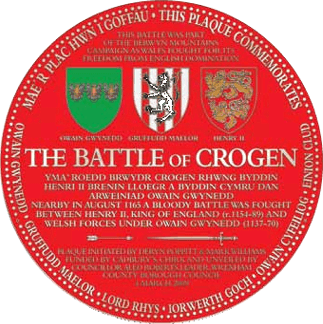Alliance of Welsh armies English Angevin Army | Date 1165 | |
 | ||
Unknown Unknown, but said to be a large army Unknown Heavy losses in the vanguard Result Decisive Welsh victory; English retreat Location Ceiriog Valley, United Kingdom | ||
Battle of crogen plaque chirk part 2
The Battle of Crogen took place in the Ceiriog Valley, Wales in 1165, between the vanguard of the forces of Henry II of England and an alliance of Welsh princes led by Owain Gwynedd. Although outnumbered, the ambush tactics and valour of the Welsh aided them in their defeat of King Henry's army. Some sources report that adverse weather conditions also played a major part in Henry's defeat. Those weather conditions however were endured by both sides.
Contents
- Battle of crogen plaque chirk part 2
- Battle of crogen dogumentary
- Background
- The battle
- Aftermath
- References
Battle of crogen dogumentary
Background
Henry II, who planned to conquer Wales and so expand the Angevin Empire, raised an army at Oswestry to march to the Berwyn mountains, via the Ceiriog Valley, in the summer of 1165. Intending to reach the fortresses of Rhuddlan and Basingwerk, Henry II expected resistance and recruited a sizeable force from his kingdoms. Owain, hearing of the invasion, raised an army at Corwen in response, comprising forces from all over Wales. Including his own forces of Gwynedd, led by himself and his brother Cadwaladr, the alliance of princes was made up of men from Deheubarth, under the leadership of Rhys ap Gruffudd, and troops from Powys.
The battle
Henry's army had the advantage of greater numbers, so Owain's tactics were to raid and ambush. He planted skirmishers in the thick woods overlooking the pass Henry would take. When Henry's army advanced into the densely wooded Ceiriog Valley, the Welsh defenders assailed them repeatedly from their positions of cover.
Realising the vulnerability of his army, Henry II ordered 2000 woodsmen to clear trees and widen the passage, allowing his forces to move more freely and quickly through the pass. The woodsmen were protected by the best of Henry's army and a powerful vanguard of pikemen, but their resistance was only effective for a short period. While the woodsmen cut the trees – his forces were ambushed at the point of Offa's Dyke (which then straddled the valley floor) at the point where "The Great Oak of the Gate of the Dead" now stands. – a strong force of Owain's troops emerged and assaulted Henry's vanguard, inflicting severe losses. This engagement was later known as the Battle of Crogen.
Henry came within a whisker of losing his life, if not for the brave action of Hugh de St Clare, the Constable of Oakwood Castle, who sacrificed his own life when he threw himself in front of a shaft meant for his King. The English forces disengaged and did indeed reach the Berwyn mountains but, hit hard by the Welsh armies, were forced to retreat from Wales altogether when Owain's forces succeeded in cutting off their supplies.
Aftermath
Estimates of the losses suffered in the battle of Crogen vary, most modern historians consider them to have been relatively light with the English army suffering the bulk of the casualties. The place where this clash occurred is called Adwy'r Beddau, "the Pass of the Graves". His attempt at suppression of the Welsh and gaining control of Wales a failure, Henry II ordered Welsh hostages to be brought to him at Shrewsbury, and there oversaw the mutilation of twenty-two prisoners, two of whom were Owain's sons. Forced to abandon the conquest of Wales, Henry returned to his court at Anjou, while retaliation for the twenty-two tortured hostages was carried out on Normans throughout the Welsh lands.
